Sigatoka Sand Dunes National Park is not just an oceanside ecosystem. It’s also the site of major archeological discoveries that link Fiji to East Asia.
The lovely view of the Korotogo lagoon from the house at which we stay in Fiji extends to the Sigatoka Sand Dunes National Park. On a clear day from the top of the hill here, we not only hear the roar of the surf as it breaks along the Coral Coast, but see the breakers crash against the sand in the distance, raising all sorts of spray.

View across the Korotogo Lagoon to the distant Sigatoka Sand Dunes
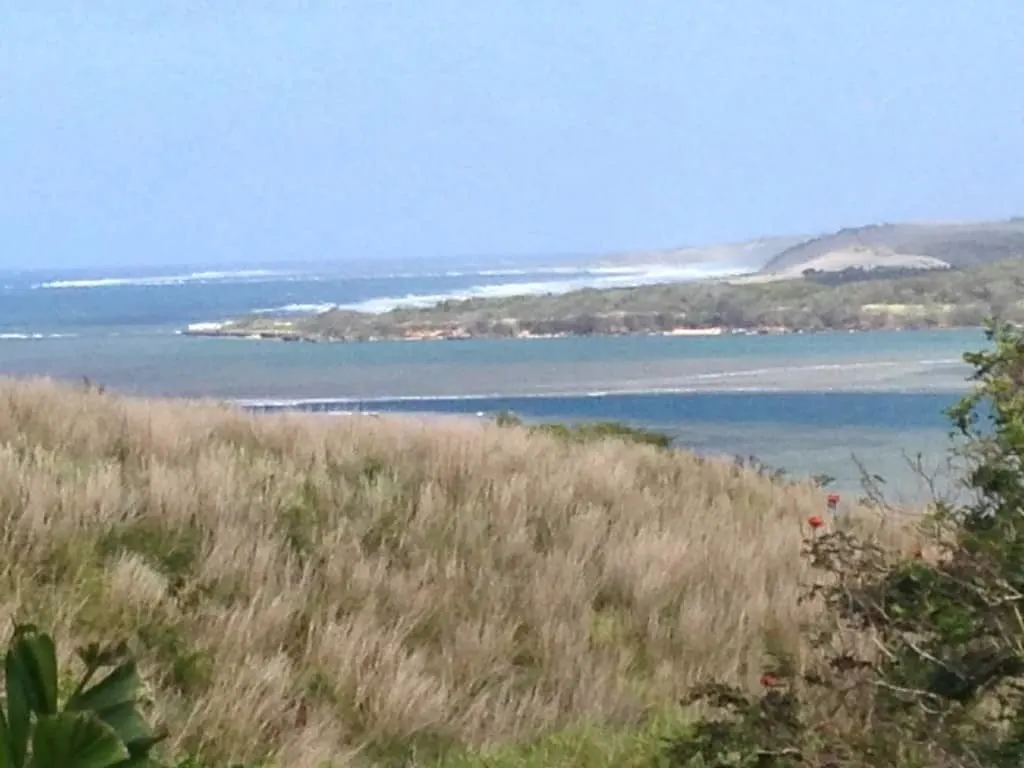
Sigatoka Sand Dunes and breaking surf in the distance
Sigatoka Sand Dunes National Park was established in the late 1980s as Fiji’s very first national park, and has been proposed as a UNESCO heritage site. Its fragile ecosystem supports a variety of wildlife and flora, including a second growth forest of mahogany trees just inland from the dunes’ ridgeline.
Legend has it that the sand dunes were formed when two spirit gods, Tamaku and Vodovata, came to this area because it was famous for rich clay soil and peaceful people. Tamaku stole some of the valuable clay and put it in a basket. When confronted by Vodovata about his theft, Tamaku dropped his basket of clay into the ocean, forming Vatulele Island (about 25km off the Coral Coast). Tamaku then flew back toward the land and began to throw sandstone rocks which fell along the coastline. The largest of these was crumbled by Vodovata over the coral coast, forming the dunes.
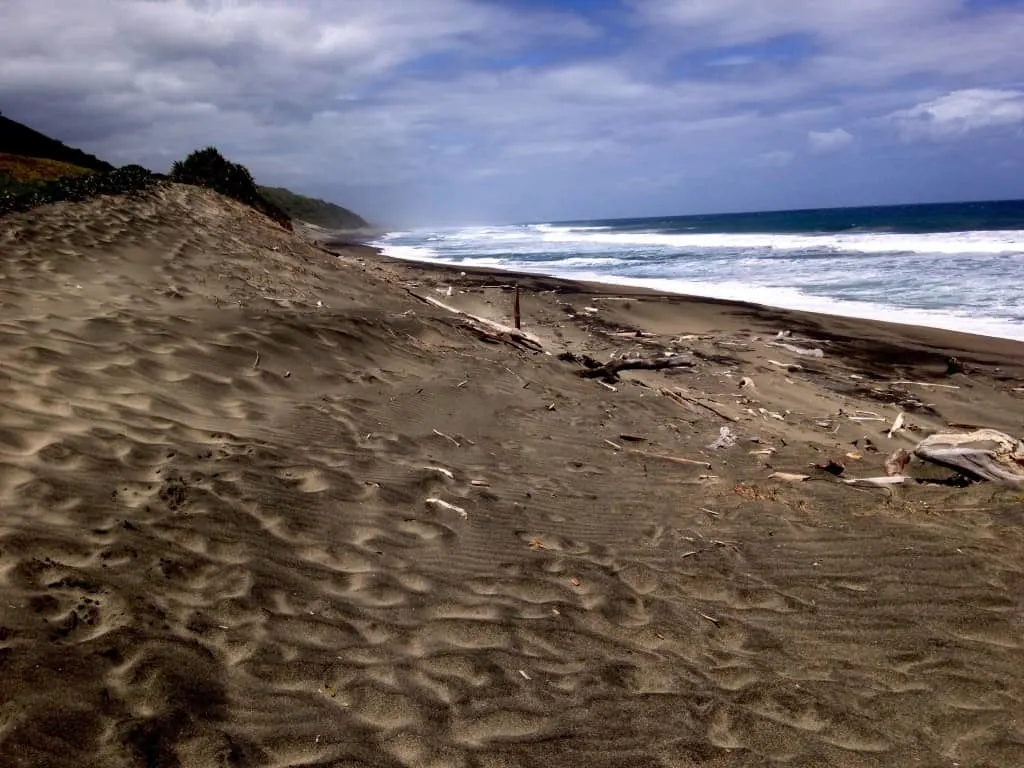
Unlike other places along the Coral Coast where a deep reef insulates the shoreline, the ocean breaks directly on Sigatoka Sand Dunes.
The mouth of the Sigatoka River was attractive to ancient people of the Lapita culture, who had come eastward beginning around 3000 years ago from Southeast Asia and the Philippines to New Guinea and the Bismarck Archipelago. Their migration spread from the South Solomon Islands and Vanuatu to Fiji and New Caledonia, and then beyond to Samoa, Tonga and the Marquesas. The Sigatoka delta provided Lapita artisans with the raw materials to make their intricately designed pottery, as well as fertile soil for growing food and rich marine life.
Archeological excavations beginning in the 1960s have revealed a burial site here which dates from around the 1st century. Containing the remains of more than 70 individuals beneath and around existing coral mounds, this site is the largest of its kind and age in the South Pacific.
On a recent visit to Sigatoka Sand Dunes, we walked the shorter of two loop trails beginning from the Visitors Center on Queens Highway.
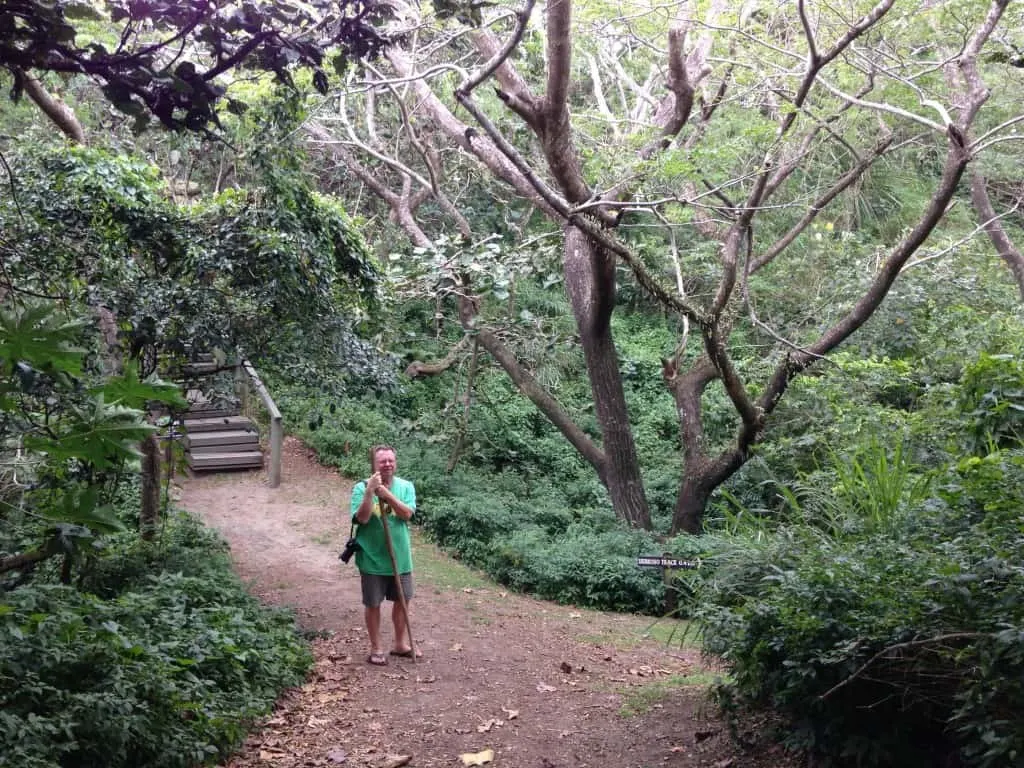
The trails at Sigatoka Sand Dunes begin in the forest
Cheerful reminders about personal safety were posted at various locations.
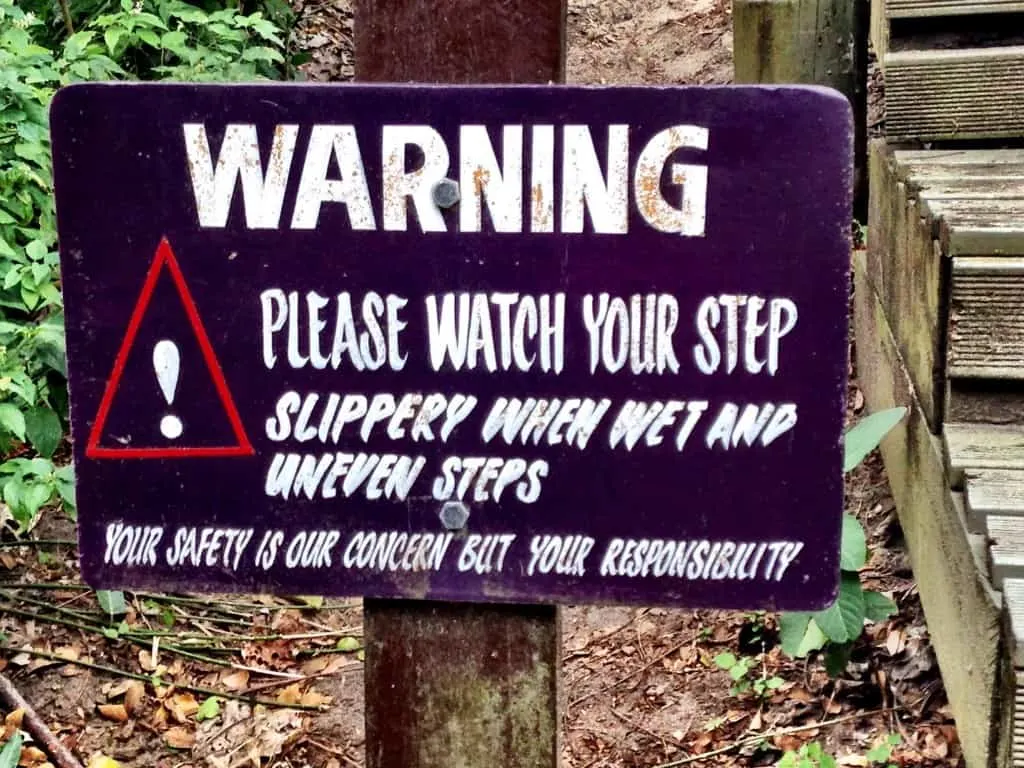
A nice way to say what’s what!
The trail descended over the first ridgeline to the dune area beyond. The dunes, which range from 20 to 60 meters high, are creeping inland at the rate of about 3 meters per year.
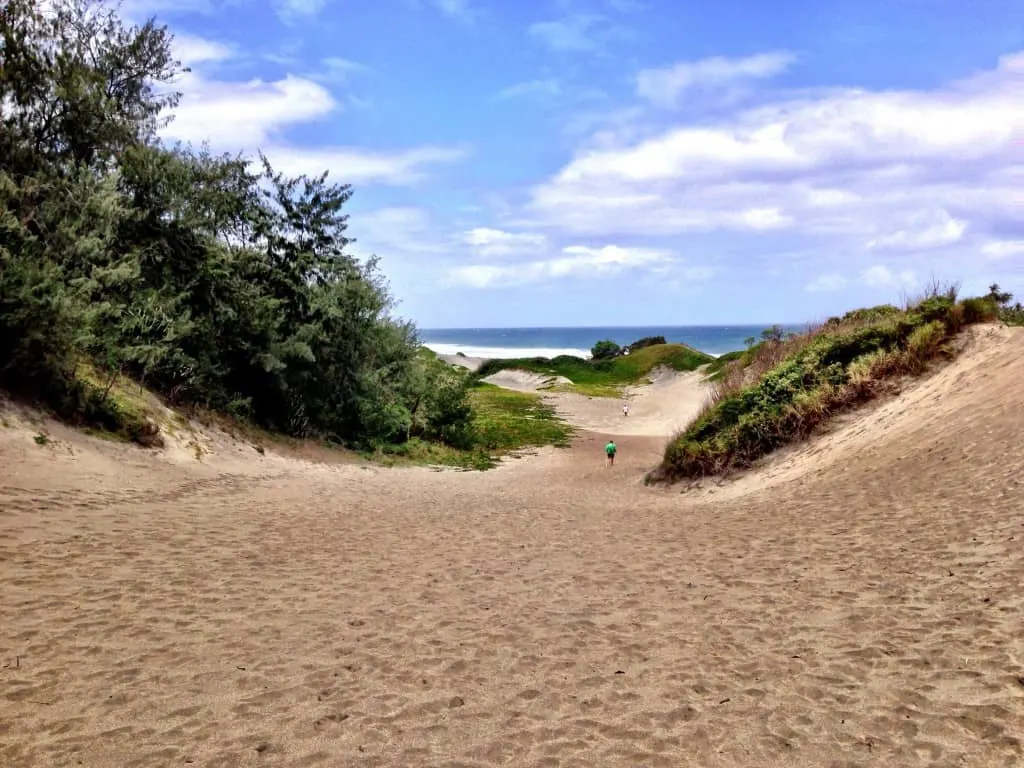
You can just barely see Pete and the park ranger ahead of him on the slope to shore
The shorter loop veers westward along the shore to an activities area. There was a stark vibe as we moved among the driftwood tipis and gathering circle constructed by children’s groups. The Park has a considerable number of programs designed for schools and special interest groups. It was easy to imagine similar structures sheltering new arrivals to this place eons ago.
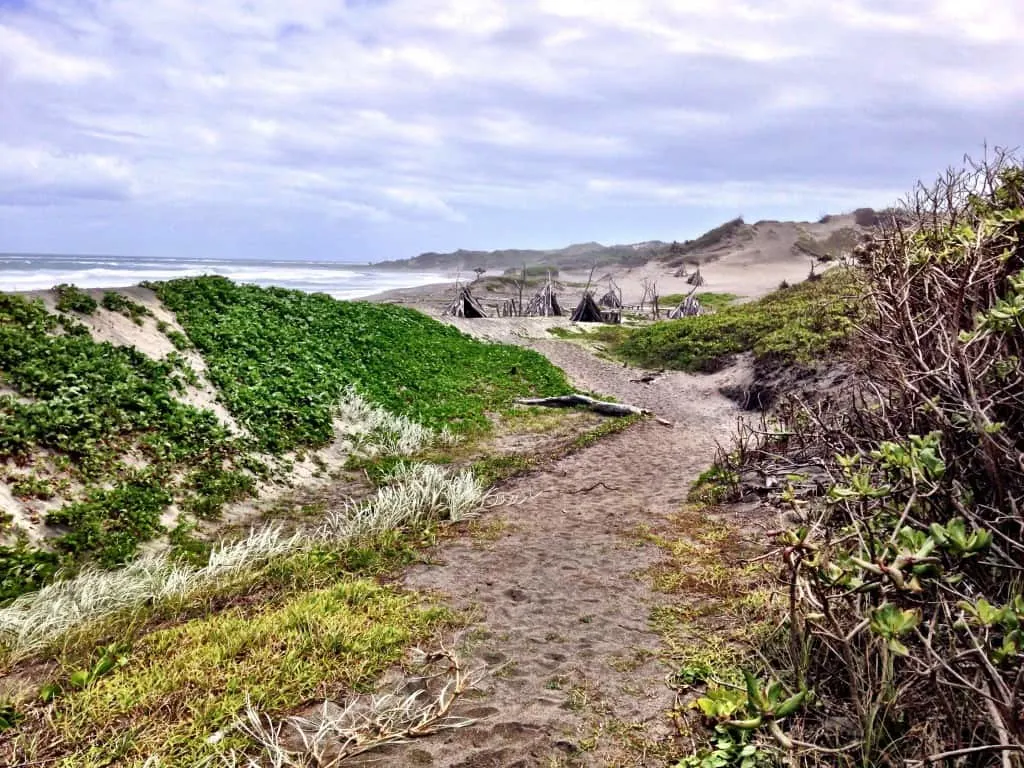
The coastal path to the tipis and gathering circle
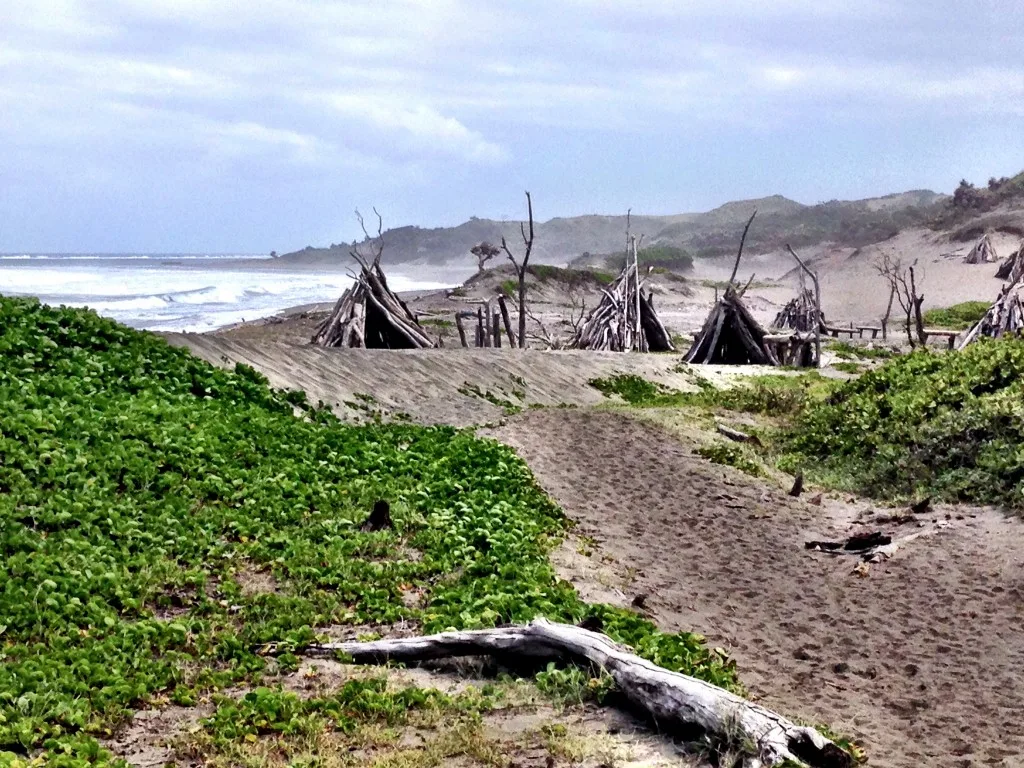
A ghostly village in the sand and spray
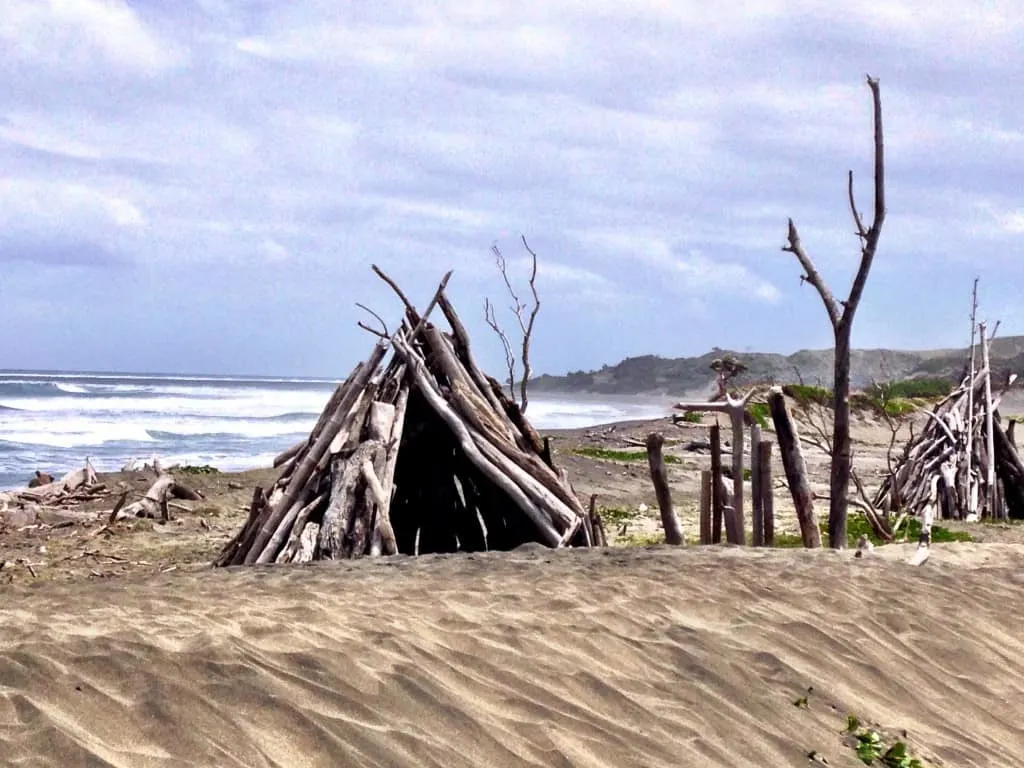
Sand was already claiming these constructs
Pete thought it might be fun to camp overnight in one of these tipis. I disagreed. I felt a sad sort of presence here. UPDATE: October 12, 2015. On our flight out of Fiji today, the airline magazine referenced an additional myth. There is a small valley in the dunes which Fijians refer to as “Nadrio” (“darkness”). Their belief is that this valley is a portal or gateway to the underworld. Their legend says that Degei, the snake god, became angry and sent a huge wave which buried a village in the sand. The neighboring villagers in Kulukulu believe that the spirits of these dead can be heard within the dunes.
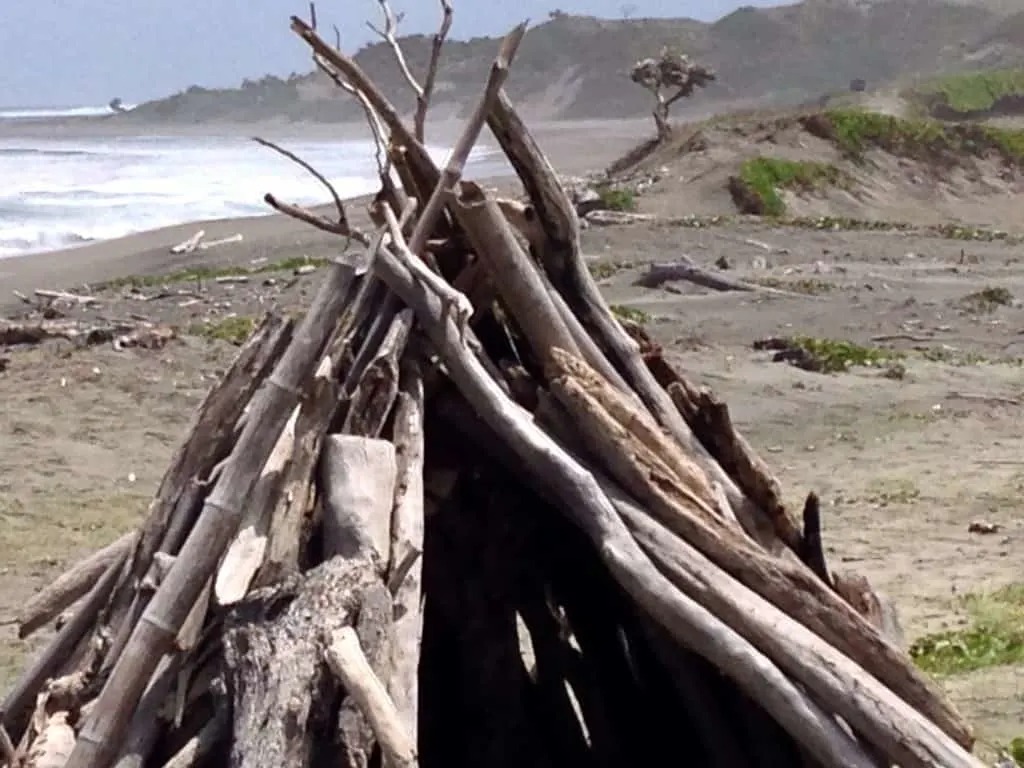
A lonely tree stands sentinel against the sea and sand
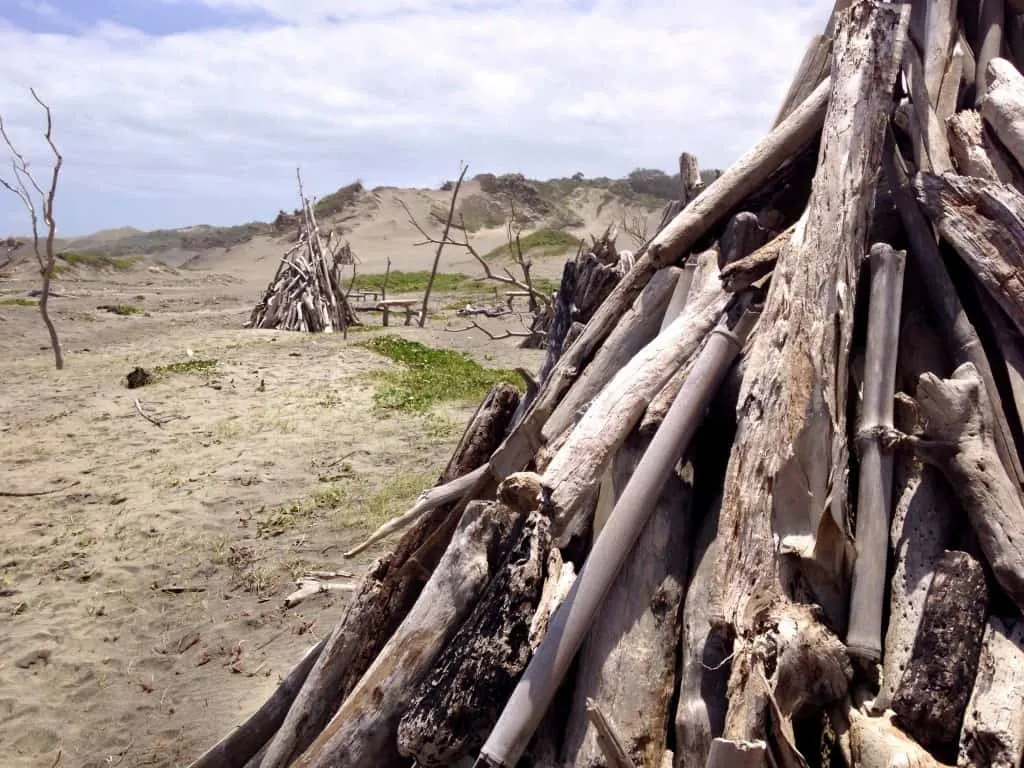
The short loop trail turns back inland at this location
The trail turns inland here, and there is a clear demarcation where visitors aren’t allowed. The sand was undisturbed and looked like it must have centuries before.
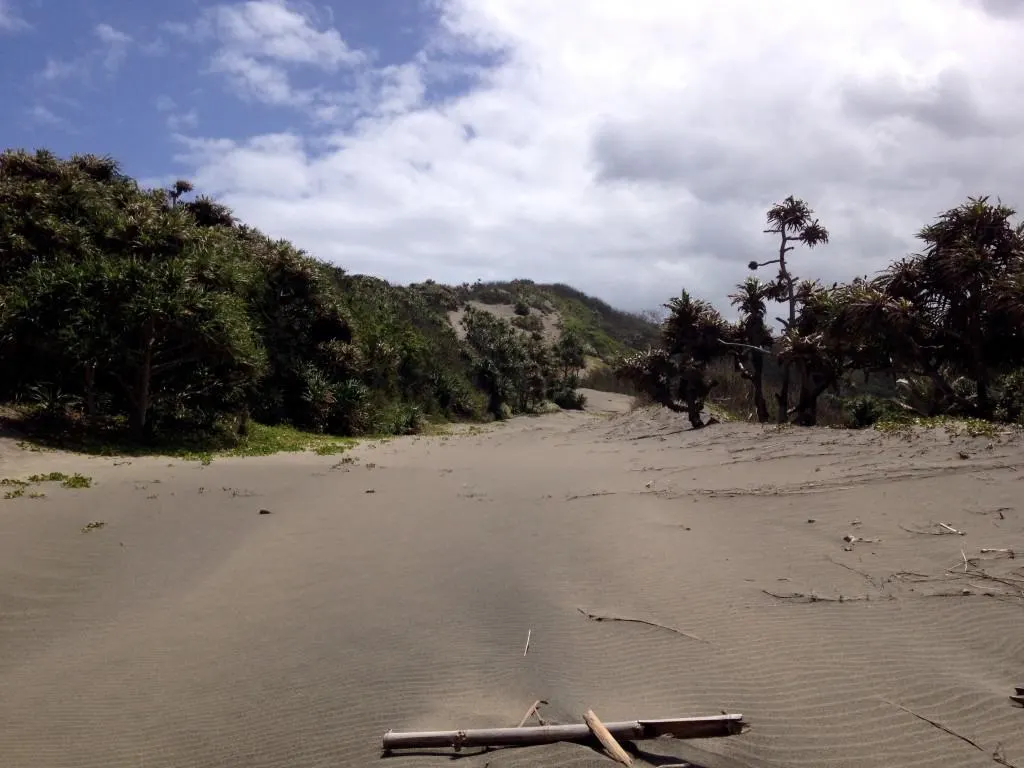
Undisturbed as it might have looked long ago
The path leads into a second-growth mahogany forest planted in the 1960s. Along the way there are places to rest and reflect.
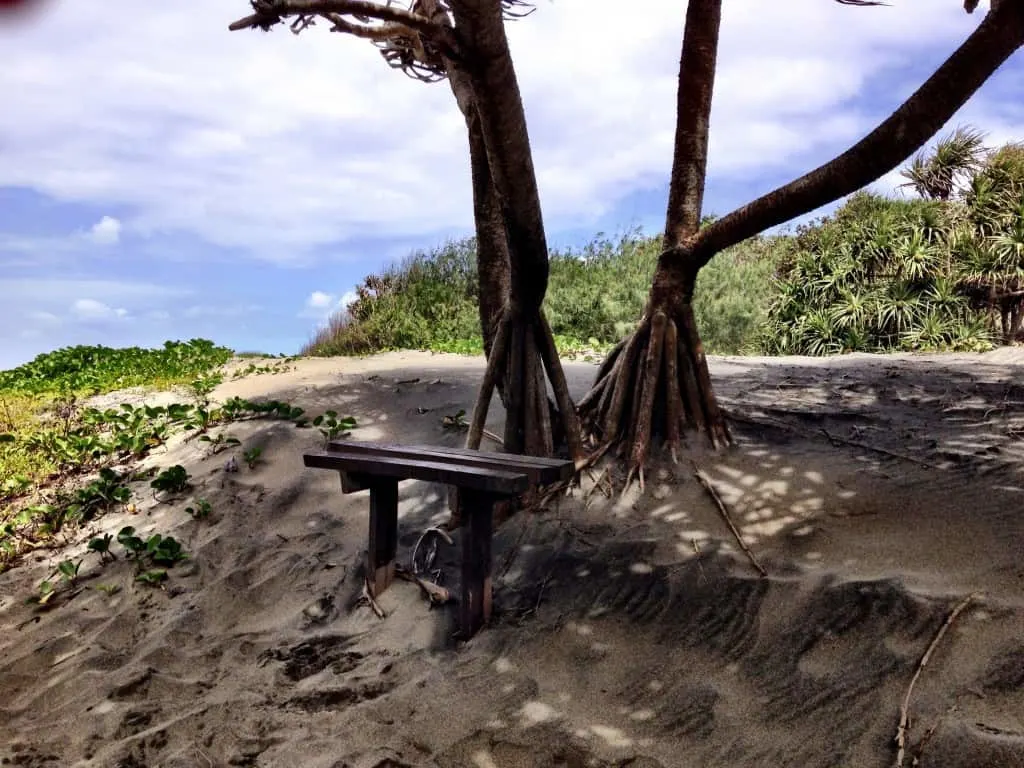
A peaceful place to rest out of the sun
Along the forest path we encountered ghostly little tree huggers the children had built. We thought these whimsical apparitions made a perfect artistic statement as to the importance of nature to the people, as well as mahogany to the Fijian economy.
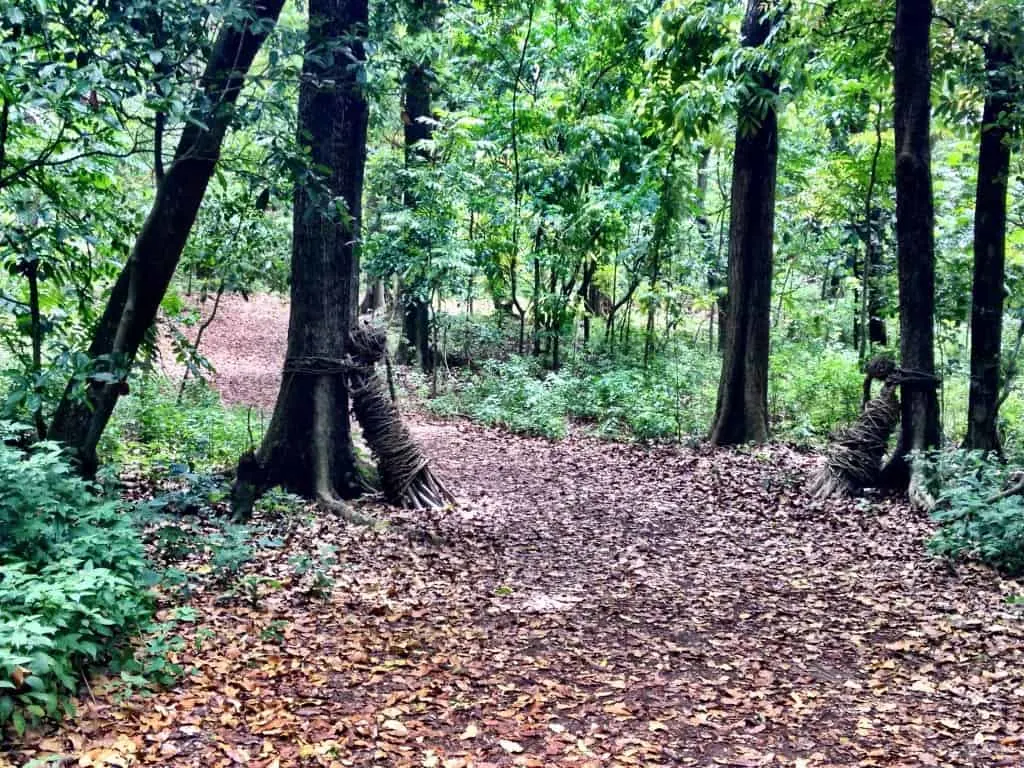
Are these the ghosts of tree huggers past along the woodland path?
Walking this route had me thinking of home. I spent my childhood summers playing at the Sleeping Bear Dunes National Monument, which has its own native legend, and other dunes along the shores of Lake Michigan. As well, the satisfying crunch our footsteps made on the leaf-strewn path had us thinking of other autumns in the American Midwest.
Our walk on the short loop took us about twice as long as the hour which is typically estimated. We ambled slowly, taking our time. While there were other visitors to the park, we seemingly had it to ourselves, encountering only the one ranger away from the Visitor Center. That’s about as perfect an experience you might hope to get.
Pinnable Image:
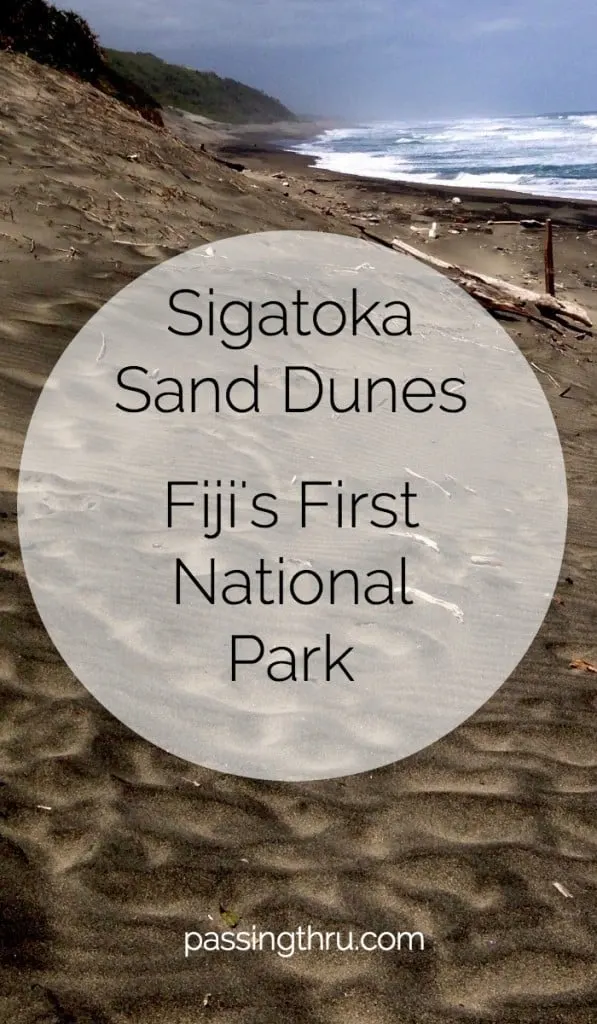
Tips and Practicalities:
The entrance to Sigatoka Sand Dunes National Park, which is managed by the National Trust of Fiji, is located on the Queens Highway ten minutes west of Sigatoka (about 90 minutes from the international airport in Nadi). Two trails, the short loop (about one hour) and the long loop (about two hours), lead visitors through a variety of ecosystems. Some elevations are steep. Open daily 8am – 5pm. Admission is $10FJD per adult. Bottled water, other beverages and ice cream available for purchase at the Visitors Center.
Tips for Trip Success
Book Your Flight
Find an inexpensive flight by using Kayak, a favorite of ours because it regularly returns less expensive flight options from a variety of airlines.
Book Your Hotel or Special Accommodation
We are big fans of Booking.com. We like their review system and photos. If we want to see more reviews and additional booking options, we go to Expedia.
You Need Travel Insurance!
Good travel insurance means having total peace of mind. Travel insurance protects you when your medical insurance often will not and better than what you get from your credit card. It will provide comprehensive coverage should you need medical treatment or return to the United States, compensation for trip interruption, baggage loss, and other situations.Find the Perfect Insurance Plan for Your Trip
PassingThru is a participant in the Amazon Services LLC Associates Program. As an Amazon Associate I earn from qualifying purchases.
To view PassingThru’s privacy policy, click here.

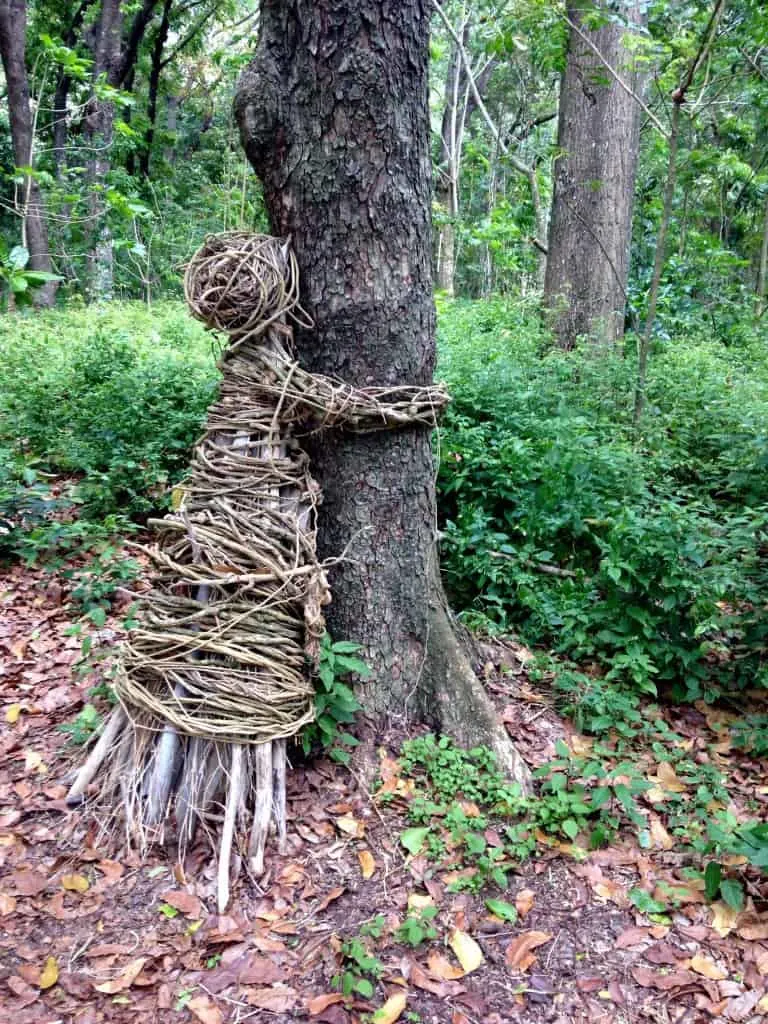
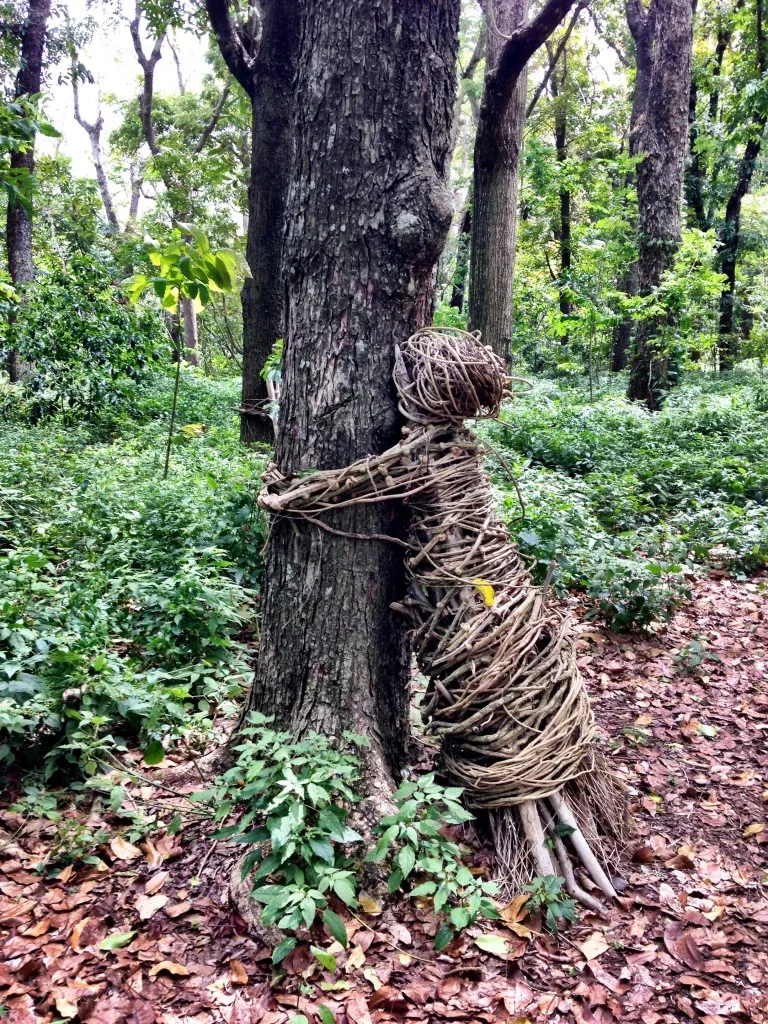
12 Affordable Places to Stay in Fiji | Passing Thru
Monday 15th of February 2016
[…] which are protected from the open ocean by a large, shallow reef, the Coral Coast is home to the Sigatoka Sand Dunes National Park and the Kula Eco Park, which showcases South Pacific […]
Patti Morrow
Tuesday 20th of October 2015
Wow, the Sigatoka Sand Dunes National Park is definitely a different look into Fiji. It's so great that you are able to spend so much time in one place and find so many extraordinary sites. Fiji is on my tentative visit list for 2016. If it comes to fruition (I'll be full-time travel writing starting 1/1/16 so finances will be tight... but.... YAY!), I'll definitely have to go to the park.
Billie Frank
Sunday 18th of October 2015
What a great looking place Sigatoka Sand Dunes National Park is. I love the ocean and discovering neat places that front on it. The history of this area seems fascinating.
Suzanne Fluhr
Sunday 18th of October 2015
I think there is something hard wired in human beings, a need to have some idea of where we came from. Every culture has a myth of creation, usually somehow tied to their physical location and landscape. I wonder if there are any linguistic similarities between the languages of the Native American tribes in the United States and people from the South Pacific region given the similarity between their dwellings, both in appearance and in name (tipis -tepees (sp?)) ?
Sue Reddel
Friday 16th of October 2015
Fiji has long been on a list of places I've wanted to travel to. You really share a lot of fascinating facts that I simply didn't know about. I'm with you on the tipis. I'd love to see them but sleeping on that dune would not be high on my to-do list.
Betsy Wuebker
Thursday 22nd of October 2015
Hi Sue - Fiji is an amazing, diverse experience, but no, no overnights in the tipis. :)